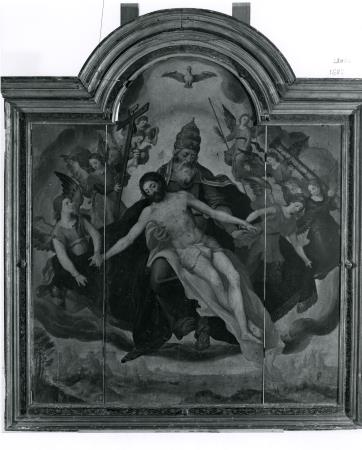Ana Diéguez-Rodríguez
Some years ago I had the opportunity to visit the art storerooms of the Museu Nacional d’Art de Catalunya on Montjuïc. I was accompanying the conservator of the museum’s Renaissance and Baroque Department, Joan Yeguas, and the group of students from the University of Lleida on the Master’s degree course in the cataloguing of works of art.

There we were able to see pieces that were not exhibited but were still very interesting, for both Spanish painting in the sixteenth and seventeenth centuries and Flemish painting in the same period. It is this last school to which I dedicate most of my research, and so I was very pleased to admire the central panel from a very large old triptych, of which only the scene of the Trinity remained, represented through the three figures of the Father holding the recumbent body of His Son, and the dove of the Holy Spirit above.

The depiction of God the Father functioning as a throne to accommodate the recumbent body of Christ is a type of iconography that was highly developed in the Middle Ages. Albrecht Dürer painted the theme in 1511 in a far more complex way on the panel in the Kunsthistorisches Museum in Vienna by including all the saints in adoration at the bottom, and by simplifying the scene to just the main figures in the foreground in the engraving that he did that same year.

In Flanders, Jan Vermeyen made his own version between 1530 and 1540. Pieter Coeck van Aelst adapted it to the triptych format, like the one conserved in the Catherijneconvent in Utrecht (Inv. No. 78), distributing the angels bearing the symbols of the passion in the side panels and bringing the Holy Trinity closer to the viewer by arranging the main figures in three-quarters, occupying the whole of the foreground.

The painting in the Museu Nacional is indebted to this Flemish adaptation of the model engraved by Dürer in the first half of the sixteenth century. In fact, the work is due to an artist very close to the workshop of Pieter Coeck, known as the Master of the Prodigal Son, working in the middle decades of the sixteenth century. He is an artist who, besides the influence of the former, shows a dependence on the models and style of another painter from Antwerp with a very productive workshop in the mid sixteenth century: Pieter Aertsen.

The central panel of the triptych of the Seven Joyful Mysteries of the Virgin from the Church of Saint Leonard in Zoutleeuw, painted by Pieter Aertsen in 1554, presents the main theme in the centre with a broad landscape at the bottom, in a formula very similar to this one. On the back of the left-hand panel, in a corner, God the Father appears with Jesus in his arms as the heavens open, observing the stoning of Saint Stephen.


Despite these compositional concomitances with the workshops mentioned, in the Museu Nacional the Master of the Prodigal Son shows a very personal style that distances him fromCoeck and Aertsen, while at the same time it defines him as a master very active in Antwerp in the middle years of the sixteenth century, between 1530 and 1560.
The landscape at the bottom is very typical of this artist, and it corresponds to the formula that he uses in his scenes of the Return of Tobias, or the Parable of the Prodigal Son, in the Museum of Fine Art in Ghent.

The types of the angels in the painting in Barcelona are also similar to the one that appears in the middle accompanying Tobias, especially the one with the scourge in his hands. The faces of the angels, delicately outlined, with wavy hair on both sides of the face, a broad nose, small mouth and round eyes, are similar to those he uses for the female faces, for example the angels scaling Jacob’s ladder, or the angel Gabriel of the Annunciation in the Triptych of the Descent from the Cross in the church in Rueda (Valladolid).
The model of the face of God the Father is reminiscent of the one the master uses for Saint Paul, in a private collection in Munich.

The scene presents a clearly classical structure framed within a pyramidal outline where the Dove of the Holy Spirit is the axis. The body of Christ, lying diagonally, is in opposition to the position of the Father, who takes the inert body of his Son in his arms. Surrounding the whole scene are the angels with the symbols of the Passion. It is a scene of great theological significance, which due to the size of the piece would be destined to occupy an important place as an altar triptych.

We do not have much information about its original provenance. It entered the Museu Nacional in 1906 on the basis of a long-term loan signed with the Real Academia de Bellas Artes de Sant Jordi in 1902.
This painting in the Museu Nacional stresses that the Master of the Prodigal Son worked regularly in the Iberian Peninsula, where his works are not restricted to small- or medium-sized formats but also include large-sized works, like this one, kept in the Museu Nacional’s collection.
Related links
Museo Nacional del Prado (inv. nº P003210). M. Díaz Padrón, “Una tabla de Jan Vermeyen identificada en el museo del Prado”, Boletín del Museo del Prado, (1984), pp. 109-112.
A. Diéguez Rodríguez, “Un Tríptico del Maestro del Hijo Pródigo en la iglesia de la Asunción de Rueda (Valladolid)”, Goya, (2006), pp. 237-244.







